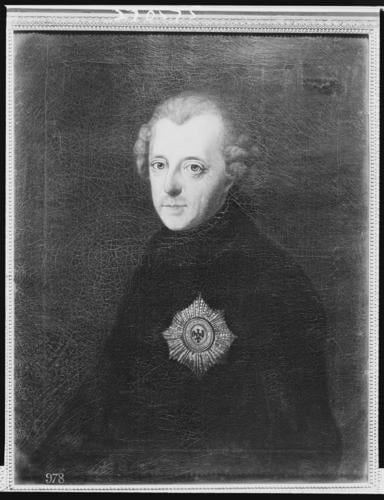Frederick II, King of Prussia (1744-97) c.1775-1800
Oil on canvas | 77.8 x 60.9 cm (support, canvas/panel/stretcher external) | RCIN 402686
-
Born in Copenhagen in 1716, Johann Georg Ziesenis was a pupil of his father Johan Jürgen Ziesenis. He became a German citizen in 1743 and was first appointed court painter in Zweibrücken, then in Mannheim. In 1760 he entered into the service of George II of Hannover and, subsequently, George III; Ziesenis also worked in Berlin and Brunswick. The Royal Collection owns a significant amount of Ziesenis portraits, illustrating members of various eighteenth-century noble German dynasties – notably from the houses of Mecklenburg-Streliz and Brunswick-Wolfenbüttel.
Producing around 260 works in his lifetime, most of which were portraits, Ziesenis is remembered for his intimate portrayals of the future wife of George III, Charlotte of Mecklenburg-Streliz, Crown Prince Frederick and Frederick II. He began his career working in a traditional baroque style but, inspired by Rubens and Van Dyck, effected a transformation in the 1750s, introducing a heightened psychology to his character studies. Ziesenis practised a new type of enlightened portraiture, the private court portrait. He depicted his subjects at ease in natural surroundings, an emphasis on education and worldliness rather than on power. In this way Ziesenis' work ranks alongside the great English eighteenth-century portraitists. Indeed, his biographer, F. F. Kuntze, states that in invention and execution Ziesenis was the highpoint of eighteenth-century German portraiture and his best work ranks alongside the great painters of the English enlightenment.
In the later part of his career, Ziesenis' art exemplified the period of Zopfstil or Citizen's Rococo, literally a "pig-tail style" coined after Louis XVI and the waning Ancien Regime. This new style stood at a transition point between late Rococo and the burgeoning reprisal of stark, Hellenic Classicism in the hands of Winckelmann, best displayed in the furniture of the time. Ziesenis' portraits of this period introduce a certain air of civic responsibility and mark a departure from the florid pleasure gardens of Rococo fashion.
Frederick reigned as King of Prussia from 1740 until 1786. He became known as Frederick the Great due to his countless military victories, particularly in the Seven Years' War, and his reorganization of Prussian armies. Frederick's rule typifies a new type of enlightened absolutism, in his essay of the subject the King remarked "my principal occupation is to combat ignorance and prejudice ... to enlighten minds, cultivate morality, and to make people as happy as it suits human nature, and as the means at my disposal permit". As well as being a patron of the arts he substantially modernised Prussian bureaucracy and the civil service. Frederick considered himself "the first servant of the state".
This painting is a poor copy of an existing Royal Collection portrait of Frederick II (RCIN 404697), which was possibly acquired by George III and is itself a copy of an original oil sketch in the possession of the House of Hanover. The Royal Collection original might be identical to that mentioned in a letter written by the Duchess of Brunswick to her brother King Frederick on February 16th, 1764. In it she states: "actuellement il (i.e. Ziesenis) m'a dit qu'il avait reçu l'ordre du Roi d'Angleterre de le (i.e. the sketch) copier pour lui". However, from George III's published letters of 1764-5, it is clear the relations with the Prussian Court were far from harmonious, the King feeling that his friendly advances to the King of Prussia had not been reciprocated. This may not have prevented him from ordering this copy of Ziesenis' portrait. It shows the King, wearing a dark green jacket with the star of the Order of the Black Eagle.Provenance
First recorded in the Queen's Guard Chamber at Hampton Court in 1861
-
Creator(s)
-
Medium and techniques
Oil on canvas
Measurements
77.8 x 60.9 cm (support, canvas/panel/stretcher external)
90.0 x 73.8 x 6.5 cm (frame, external)
Alternative title(s)
Frederick The Great of Prussia (1744-97)









